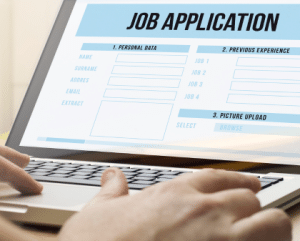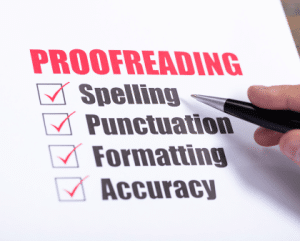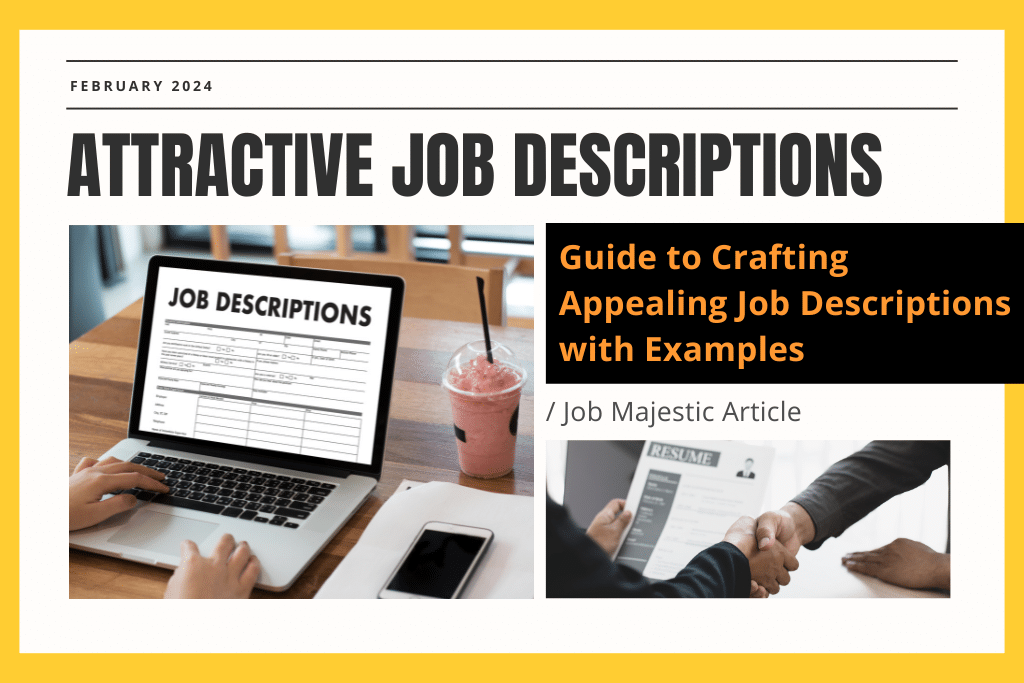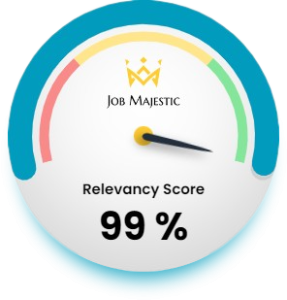In the competitive landscape of talent acquisition, the power of an attractive job description cannot be overstated. It’s not just a summary of duties and requirements; it’s a marketing tool for your company, a first impression that can attract the right kind of candidates. Here are essential tips for writing job descriptions that stand out.

1. Start with a Clear, Engaging Job Title
The job title is the first thing candidates see. Make it clear, concise, and free of grammar errors. Avoid overly creative titles that might confuse job seekers. The title should accurately describe the job and align with industry standards to make it easy to identify. It should also have meaning.
Craft job titles that accurately reflect the role, avoiding buzzwords and uncommon terms. Realistic titles enhance searchability for qualified candidates, ensuring clarity about the job’s duties and attracting those with relevant skills and experience.
Bad Example:
Job Title: Social Media Wizard
This title lacks accuracy, as it doesn’t clearly describe the role and may be perceived as a confusing buzzword without meaningful information about the actual responsibilities. It may not be easily understood by candidates seeking social media-related positions.
Good Example:
Job Title: Social Media Manager
This title clearly reflects the role, using a common and understandable term, ensuring candidates grasp the level of responsibility associated with the position.

2. Write a Compelling “About Us” Introduction
Begin with a brief overview of your company. This is your chance to sell your organisation: mention your core values, culture, and what sets you apart from others. A good introduction can make candidates excited about the prospect of working for you.
Begin your company introduction with a captivating statement to grab attention, then quickly summarise your company’s industry, size, and location. Emphasise your core values and unique culture, showcasing what sets your company apart. Use positive language to create excitement about future prospects and relate to potential candidates’ aspirations. Conclude with an invitation to explore job opportunities at your company.
Example:
Welcome to InnovateTech, a trailblazer in the tech industry with a vibrant team based in Silicon Valley. At our core, we value creativity, collaboration, and sustainability, driving us to be industry leaders in innovative solutions. We have a lively and inclusive culture, with monthly brainstorming sessions and annual global retreats, setting us apart in a competitive market. We’re excited about shaping a smarter future and invite ambitious professionals to join our journey. Discover the opportunities that await you at InnovateTech by visiting our careers page.

3. Describe the Role Clearly
Outline the key responsibilities of the position. Be specific about what the day-to-day of the role entails, but avoid an exhaustive list. Use bullet points for clarity and focus on the duties that are essential to the job.
You can collaborate with hiring managers to outline specific, measurable tasks for the role. Instead of vague statements, provide detailed descriptions of responsibilities, such as using specific technology for marketing tasks. Keep the list concise, as too many duties can imply micromanagement and deter qualified candidates who value initiative. Focus on the core tasks that represent the daily work of the role, keeping in mind that responsibilities may evolve with business goals. Avoid listing every possible task, but ensure the main aspects of the job are clearly communicated.
Bad Example:
“You will join our Sales team and work on sales-related tasks.”
Good Example:
“As a Sales Associate, you’ll drive customer acquisition through targeted outreach, utilising CRM tools to analyse sales data and inform strategic growth tactics.”

4. List Required and Preferred Qualifications
Distinguish between the qualifications that are essential and those that are nice to have. Include specific skills, experiences, and educational backgrounds required for the role. Remember to mention both hard skills (like technical expertise) and soft skills (like communication and leadership).
Required Qualifications:
- Hard Skills: Outline specific technical skills and knowledge necessary for the role. For example, if it’s a marketing position, specify proficiency in tools like Google Analytics or experience in content management systems.
- Experience: Clearly state the minimum years of experience required in a similar role or industry. For instance, if it’s a managerial position, specify the minimum number of years of leadership experience.
- Education: Specify any essential educational background, certifications, or degrees required for the position. This could include a relevant degree or professional certifications.
Example: “Required qualifications include a Bachelor’s degree in Marketing, a minimum of 3 years of experience in digital marketing, and proficiency in SEO analytics tools.”
Preferred Qualifications:
- Additional Skills: Mention any extra skills or qualifications that would be beneficial but are not mandatory. This could include familiarity with additional software, languages, or other tools relevant to the role.
- Soft Skills: Highlight interpersonal and communication skills, leadership abilities, adaptability, or any other soft skills that would enhance the candidate’s fit within the team and organisation.
Example: “Preferred qualifications include experience with email marketing automation tools and strong interpersonal skills for effective collaboration within cross-functional teams.”

5. Be Transparent about Benefits and Development Opportunities
Highlight the role’s contribution to organisational success and growth opportunities while providing transparent details on salary, bonuses, and benefits to attract candidates aligned with both career aspirations and compensation expectations. Those include:
Development Opportunities
Training Programs:
- Mentioning access to workshops, seminars, conferences, or online courses relevant to the position.
Example: “Access to ongoing training programs and industry conferences to enhance your skills and knowledge.”
Skill Development Initiatives:
- Highlighting initiatives that focus on developing specific skills required for the role.
Example: “Structured skill development initiatives tailored to enhance your expertise in [specific skill set].”
Benefits
Health Insurance:
- Offering comprehensive health insurance coverage for employees and, in some cases, their dependents.
Example: “Comprehensive health insurance coverage, ensuring you and your family have access to quality healthcare.”
Wellness Programs:
- Offering programs that promote employee well-being, such as fitness classes, mental health resources, or wellness incentives.
Example: “Participate in our wellness programs, including fitness classes and mental health resources, to support a healthy work-life balance.”
Flexible Work Arrangements:
- Highlighting flexibility in work schedules, remote work options, or compressed workweeks.
Example: “Flexible work arrangements, including remote work options, to accommodate your lifestyle and priorities.”
Other Unique Perks
For instance, highlight social events, team outings or company trips to emphasise the importance of teamwork, and showcase thoughtfully designed workspaces to convey your commitment to employee well-being and productivity which is work life balance.

6. Encourage Diversity and Inclusion
Use inclusive language that makes all candidates feel welcome to apply. Highlight your company’s commitment to diversity and inclusion, which can be a major attractor for top talent.
Example
Original: “We are looking for a candidate to join our dynamic team. Responsibilities include project management and collaboration with cross-functional teams.”
Enhanced with Inclusive Language and Diversity Emphasis: “Join our dynamic team! We actively welcome diverse candidates and celebrate differences. Project management and collaboration with cross-functional teams are key responsibilities. At [Your Company Name], we’re committed to fostering an inclusive workplace where everyone is valued.”

7. Simplify the Job Application Process
A complicated application process can deter great candidates. Provide clear instructions on how to apply and what the next steps will be. Ensure the process is as streamlined as possible.
Explore exciting opportunities on our user-friendly platform, Employer.JobMajestic.com. We’ve designed it to make the application process hassle-free, ensuring a smooth experience for candidates applying to your job.

8. Proofread and Edit
Finally, ensure your job description is free from grammatical errors and typos. A well-written, error-free job description reflects professionalism and attention to detail.
Conclusion
An attractive job description is more than a list of requirements; it’s a window into your company culture and an invitation to potential candidates to start a journey with your organisation. By following these tips, you can craft job descriptions that not only attract qualified candidates but also showcase the best of what your company has to offer.
![]()







